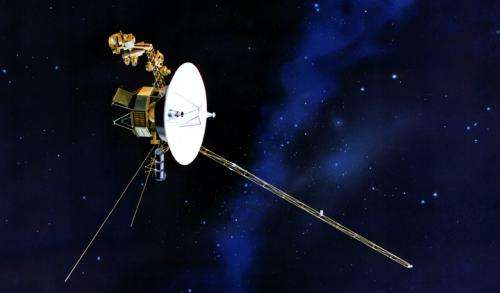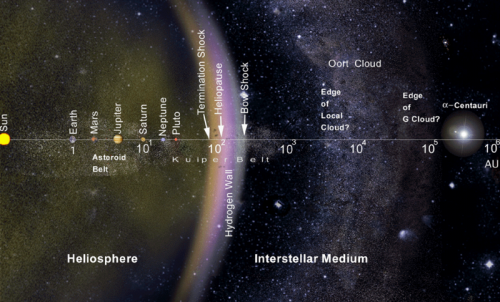Voyager 1 measures magnetic mayhem

When Voyager 1 passed into the heliosheath in 2004, it became the first man-made object to explore the remote edge of the Sun’s magnetic influence. Launched by NASA on September 5, 1977, the probe was designed to study the outer Solar System and eventually interstellar space. One of its missions was to look for the heliopause – the boundary at which the solar wind transitions into the interstellar medium. What it found was mayhem...
According to NASA, Voyager 1 has crossed into an area where the velocity of the hot ionized gas, or plasma, emanating directly outward from the sun has slowed to zero. Scientists suspect the solar wind has been turned sideways by the pressure from the interstellar wind in the region between stars. “The solar wind has turned the corner,” said Ed Stone, Voyager project scientist based at the California Institute of Technology in Pasadena, Calif. “Voyager 1 is getting close to interstellar space.”
Now it has entered the heliosheath, an area ranging from 1.5 to 15 billion kilometers thick (930 million to 9.3 billion miles) and starting roughly 14 billion km (8.7 billion mi) from the Sun. But there’s nothing quiet here. This is the area where outgoing flows of solar wind begin to be repelled by interstellar particles and magnetic fields pushing towards the solar system. While passing through the heliosheath, Voyager 1 experienced many sudden and drastic changes in the surrounding magnetic field driven by structures called current sheets.

The team of L. F. Burlaga: Geospace Physics Laboratory, NASA Goddard Space Flight Center and N. F. Ness of the Institute for Astrophysics and Computational Sciences have been studying the ongoing results sent back by Voyager and have come to a new conclusion – there are three distinct types of current sheets.
“The structures, appearing as proton boundary layers (PBLs), magnetic holes or humps, or sector boundaries, were identified by characteristic ffluctuations in either magnetic field strength or direction as the spacecraft crossed nearly 500 million km (310 million mi) of heliosheath in 2009. PBLs are defined by a rapid jump in magnetic field strength, with one observed event resulting in a doubling of the field strength in just half an hour.” said the team. “Passing through a sector boundary led to a sudden change in direction of the magnetic field. Magnetic holes saw the field strength drop to near zero before returning to the original background strength. Magnetic humps consisted of a sudden spike in strength and then a return to initial levels.”
But this isn’t the first time the Voyager has returned zero readings. In December 2004 the intrepid probe broke the barrier of the termination shock and data from Voyager 1′s Low-Energy Charged Particle Instrument was used to deduce the solar wind’s velocity. When the speed of the particles matched the speed of the spacecraft, scientists knew they had a null number on their records. “When I realized that we were getting solid zeroes, I was amazed,” said Rob Decker, a Voyager Low-Energy Charged Particle Instrument co-investigator and senior staff scientist at the Johns Hopkins University Applied Physics Laboratory in Laurel, Md. “Here was Voyager, a spacecraft that has been a workhorse for 33 years, showing us something completely new again.”
A new is what we need to continue our understanding of what lay at the furthest reaches of our now explorable space. Says Burlaga, “The firsthand detections made by Voyager 1 are likely to be extremely important for researchers trying to decide between current leading theories for the source and structure of current sheets.”
Source: Universe Today




















